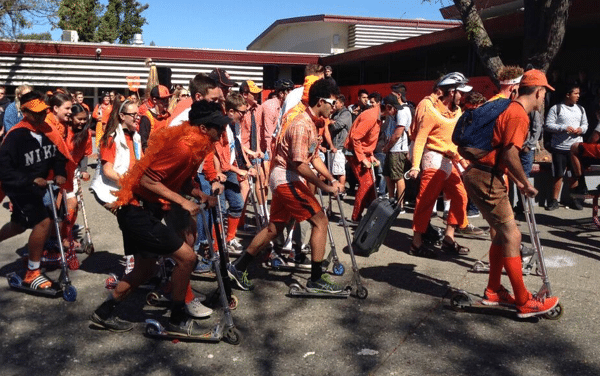
World wide transportation accounts for only 13 percent of our carbon footprint 1. However, in the Bay Area transportation is biggest GHG contributor, 2 and here in semi-rural Sonoma County, transportation accounts for more than half of our greenhouse gas emissions 3. We drive a lot.
So what can we do about it? The Sonoma County Transit Authority listed Safe Routes To School programs like our Eco2school program as a key component to reaching our emission reduction goals. Student commute programs like The Climate Center’s ECO2school Program educate and encourage students to try new healthier behaviors while also reducing greenhouse gas emissions.
In Sonoma County there are 21,569 high school students. According to data collected by the ECO2school program, 13,373 of them live in walk or bike distance (3 miles) from school. Yet only about 3,000 of them or 18 percent use active transportation such as walking and biking. If the other 10,000 students who live in proximity to school walked or biked just one day a week the carbon savings would be significant. In addition, they would be building a healthy habit that can last a lifetime. Once students start biking they realize it is fun and bike commutes don’t take as long as you think.
“I love zipping by all the cars stuck in the parking lot when I hop on my bike to ride home from school.” Says Trae Petruska, Windsor High School Senior. “Even better I ride on a creek path. I see water, and trees on my ride instead of traffic.”

It is not just students however, who need to start changing behavior. Increased physical activity associated with walking and biking generates improvement in community health. Increasing walking and bicycling from 4 to 22 minutes daily reduces GHG emissions and the risk of cardiovascular disease and diabetes by 14 percent. This could save Californians an estimated $34 billion in health care and deferred road maintenance costs 3. Most of us are not willing or able to give up our cars completely. But about 60 percent of the trips we take are within a 3-mile radius of our home. Imagine if the half a million people living in our community made a commitment to walking or biking for short trips. There would be less traffic congestion, less road rage, cleaner air, fitter and happier constituents. And of course the carbon savings would be immense.
So, challenge yourself to start walking and cycling. Support your children (or your parents) to do the same. Like bringing bags to the store, recycling cans, composting yard waste, and refilling water bottles, cycling is a habit we can learn.
- https://www3.epa.gov/climatechange/test/climatechange/ghgemissions/global.html
- http://www.baaqmd.gov/~/media/files/board-of-directors/2015/agenda_14_preliminary-climate-protection-program-update-pdf.pdf
- http://scta.ca.gov/wp-content/uploads/2016/07/Draft-CTP-7-1-16_web.pdf
